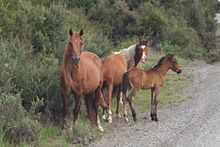Kaimanawa horse

Wild horses at Spirits Bay
|
|
| Country of origin | New Zealand |
|---|---|
| Traits | |
| Distinguishing features | Feral horses, wide range of body types and colours |
| Breed standards | |
Kaimanawa horses are a population of feral horses in New Zealand that are descended from domestic horses released in the 19th and 20th centuries. They are known for their hardiness and quiet temperament. The New Zealand government strictly controls the population to protect the habitat in which they live, which includes several endangered species of plants. The varying heritage gives the breed a wide range of heights, body patterns and colours. They are usually well-muscled, sure-footed and tough.
Horses were first reported in the Kaimanawa Range in 1876, although the first horses had been brought into New Zealand in 1814. The feral herds grew as horses escaped and were released from sheep stations and cavalry bases. Members of the herd were recaptured by locals for use as riding horses, as well as being caught for their meat, hair and hides. The herd declined as large scale farming and forestry operations encroached on their ranges, and only around 174 horses were known to exist by 1979. The Kaimanawa herd was protected by the New Zealand government in 1981, and there were 1,576 horses in the herd by 1994. A small, mostly unmanaged population also exists on the Aupouri Peninsula at the northern tip of the North Island. Roundups have been carried out annually since 1993 to manage the size of the herd, removing around 2,800 horses altogether. The Kaimanawa population is listed as a herd of special genetic value by the United Nations' Food and Agricultural Organization, and several studies have been conducted on the herd dynamics and habits of the breed.
The first horses were introduced to New Zealand by Protestant missionary Reverend Samuel Marsden in December 1814, and wild horses were first reported in the Kaimanawa Range in central North Island of New Zealand in 1876 . The Kaimanawa breed descended from domestic horses that were released in the late 19th century and early 20th century in the middle of the North Island around the Kaimanawa mountains. Between 1858 and 1875, Major George Gwavas Carlyon imported Exmoor ponies to Hawkes Bay and crossed them with local stock to produce the Carlyon pony. These Carlyon ponies were later crossed with two Welsh stallions, Kinarth Caesar and Comet, imported by Sir Donald McLean, and a breed known as the Comet resulted. At some point during the 1870s, McLean released a Comet stallion and several mares on the Kaingaroa Plains and the bloodline apparently became part of the wild Kaimanawa population. Other horses were added to the bloodline through escapes and releases from local sheep stations and from cavalry units at Waiouru that were threatened with a strangles epidemic. It is also thought that in the 1960s Nicholas Koreneff released an Arabian stallion into the Argo Valley region.
...
Wikipedia
